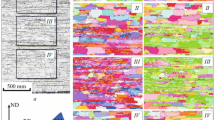Abstract
A method for the quantitative measurement of the components of the texture of deformed metal from a diffractometric curve is proposed. This was applied to the analysis of the orientations of 92% rolled iron. It is shown that the basic orientation of rolled iron is an axial texture with the axis [111] perpendicular to the plane of rolling. We then have in decreasing order (112) < 110 >, (001) [110], (111) < 112 >.
Similar content being viewed by others
References
C. S. Barret, The Structure of Metals [Russian translation], Metallurgizdat, 500, 1948.
G. Kurdjumov and D. Sachs, Zs. Physic.,62, 592, 1930.
M. Gensamer and R. F. Mehl, Trans. AIME,120, 277, 1936.
F. Haebner and H. Weik, Arch. Eisenhüt.,27, no. 3, 153–160, 1956.
L. G. Schulz, J. Appl. Phys.,20, 1030, 1949.
M. Arbuzov, Collected Works on Technical Physics [in Russian], 57, 1948.
G. M. Vorob'ev, FMM,16, 2, 285, 1963.
L. I. Lysak and L. V. Tikhonov, Voprosy fiziki metallovi metallovedeniya, p. 27, 1959.
Author information
Authors and Affiliations
Rights and permissions
About this article
Cite this article
Vorob'ev, G.M. Analyzing orientations from a quantitative pole figure of rolled iron. Soviet Physics Journal 10, 61–65 (1967). https://doi.org/10.1007/BF00819797
Revised:
Issue Date:
DOI: https://doi.org/10.1007/BF00819797




